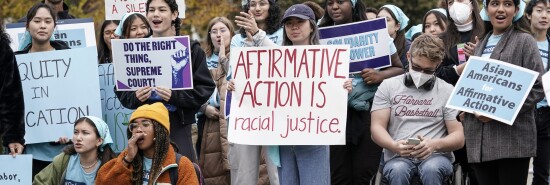
Colleges can still have diversity without racist affirmative action policies
Brad Polumbo
On Thursday morning, the Supreme Court struck down affirmative action as we know it. The 6-3 decision ruled that at public universities such as the University of North Carolina and private universities that receive government funding such as Harvard, race-conscious admissions preferences are unlawful, violating the 14th Amendment and Title VI, respectively.
Cue the progressive panic.
DESPITE LEFT’S HYSTERIA, THE SUPREME COURT IS WORKING AS IT SHOULD
https://twitter.com/nytimes/status/1674422849011089411 https://twitter.com/TPostMillennial/status/1674432432404312073 https://twitter.com/mkraju/status/1674431239485554694
This ruling is a win for equality under the law. After all, affirmative action regimes explicitly discriminate against applicants, most often Asian applicants, because of their skin color. On average, you need significantly higher test scores to get into public and private colleges as a white or Asian person than as a black person, for example. But critics on the Left will surely fearmonger about how an end to racial discrimination in college admissions will sabotage racial equality and deprive racial minorities of opportunities to get ahead.
Thankfully, this isn’t inherently true. Even without affirmative action, colleges can still have diversity through merit-based, race-neutral admissions policies. You don’t have to take my word for it; we’ve seen this play out in the real world time and time again.
The state of Oklahoma, for example, banned affirmative action in public education via a voter referendum in 2012. Yet the University of Oklahoma has only gotten more diverse since then, not less. (This doesn’t mean that ending affirmative action increases diversity, of course, but it does suggest you can still have diversity without affirmative action.)
https://twitter.com/brad_polumbo/status/1674426692998434816
The state of Texas also offers an example of how racially neutral, merit-based policies can offer opportunities to minority communities.
Texas famously implemented a “top 10%” rule in 1997 — now changed to 6% — where the top 10% of the graduating class at public Texas high schools were guaranteed admission to all public universities in the state. Data from the University of Austin shows how students admitted under this rule, about 75% of the 2016 freshman class, were remarkably more diverse than the other 25% admitted under a normal admissions process. In particular, the Hispanic student body almost doubles under this merit-based approach.
It’s almost like racial minorities are fully capable of succeeding without racial preferences.
Of course, it’s certainly true that if you actively put your thumb on the scale and favor certain racial groups over others (which is what affirmative action does), you will typically have a more diverse student body than otherwise. But it’s clearly not true that in the absence of racially discriminatory admissions policies, colleges will completely lack diversity and student bodies will inevitably be whiter than Wonder Bread.
One thing colleges can and should do is offer students “affirmative action” based on their family’s level of income. It’s absolutely true that students from wealthy families have access to tutors and SAT prep courses in ways students from poorer families could only dream of. As a result, it’s not really fair to judge them by the exact same standard when the resources they’re starting with are so different.
Yet even though such an income-focused affirmative action approach would be race-neutral, it would still disproportionately benefit minority students, because wealth gaps exist between the races on average. At the same time, this type of system would avoid a paradoxical result often incurred by the current race-based affirmative action schemes, where incredibly wealthy and privileged immigrants from the upper crust of African societies are admitted in the name of uplifting disadvantaged racial minorities.
Another thing universities could do to boost diversity would be to eliminate “legacy” admission preferences, wherein applicants whose parents attended the college in question are favored. These policies have no basis in merit and overwhelmingly benefit white, affluent people. But most of the same elite universities telling the Supreme Court they must have affirmative action to preserve their diversity are, of course, unwilling to do away with their special privilege system for donors’ children. (Apparently, diversity is important to them only so long as it wouldn’t hurt their fundraising efforts.)
CLICK HERE TO READ MORE FROM RESTORING AMERICA
Remember that even before this Supreme Court ruling, nine states had already banned affirmative action: California, Arizona, Florida, Idaho, Michigan, Nebraska, New Hampshire, Oklahoma, and Washington. Minority students still have plenty of opportunities in these states; California is not known to be a far-right, racist hellscape, after all.
And, from income-based affirmative action to scrapping legacy admissions, colleges still have plenty of tools at their disposal that can help preserve diversity on campus. So, when you see the hyperbolic warnings about how this ruling will set America back decades, feel free to ignore them for the hysterical, partisan nonsense they truly are.
Brad Polumbo (@Brad_Polumbo) is an independent journalist and the co-founder of BASEDPolitics.
